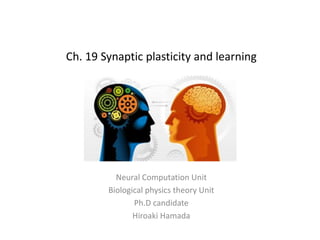
Ch 19 synaptic_plasticity
- 1. Ch. 19 Synaptic plasticity and learning Neural Computation Unit Biological physics theory Unit Ph.D candidate Hiroaki Hamada
- 2. Synaptic plasticity and learning Learning and neural mechanism Synaptic structure Potentiation of synaptic efficacy (long- term potentiation, LTP) Reduction of synaptic efficacy (long- term depression, LTD) Learning rule (Hebbian rule): Pre- and Post-synaptic neurons’ activity
- 3. Contents 19.1 Hebb rule and experiments 19.2 Models of Hebbian learning - Oja’s rule
- 4. 19.1 Hebb rule and experiments Hebbian Learning (Hebb, 1949) Synaptic plasticity (1970’s studies) ‘When an axon of cell A is near enouth to excite cell B and repeatedly or persistently takes part in firing it, some growth process or metabolic change takes place in one or both cell such that A’s efficiency, as one of the cells firing B, is increased.’ “fire together, wire together ”(Shatz, 1992) Stabilization of neural dynamics Hopfield network Unsupervised learning No notion about ‘good’ or ‘bad’ Donald O. Hebb (1904-85) from wikipedia
- 5. 19.1.1 Long-term potentiation (LTP) LTP is a persistent strengthening of synapses based on pre-and- post synaptic activity. A. presynaptic stimulation and postsynaptic recording - means of a second electrode - Test stimulation B. A sequence of high- frequency stimulation C. presynaptic pulse stimulation and see response. - check the response to pulse stimulation - Compare to the first stimulation Whether increase of relative amplitude
- 6. Example: Voltage dependence of LTP LTP and LTD are dependent on amplitude of the membrane potential of the post-synaptic neuron.
- 7. 19.1.2 Spike-timing-dependent plasticity (STDP) Paring window is spike-timing dependent Bi and Poo(2001) for the review A. intracellular electrodes in both pre-and-post synaptic neurons (j and i). Test stimulation to the pre- synaptic neuron B. both neurons are repeatedly stimulated at a very precise timing. C. test stimulation and observe response. Pairing timing decides increase or decrease of synaptic plasticity, and its amplitude. ij tj f: timing of firing in the j-th neuron ti f: timing of firing in the i-th neuron
- 8. Short Abridgement Two main factors for synaptic plasticity - Neural activity of both pre-and-post synaptic neurons - Timing of pairing (STDP rule)
- 9. 19.2 Models of Hebbian learning Firing rate models are used for the artificial networks. Two aspects of weight change based on the Hebbian Rule Locality and Joint activity Bilinear term or higher order terms are necessary for the Hebbian Rule such as 19. 1 Undetermined function F() Apply Taylor expansion w.r.t. vi = vj = 0 Joint activity In the case of c11 corr is constant…. If c11 corr > 0, called the Hebbian Rule. If c11 corr < 0, called the anti-Hebbian Rule.
- 10. But what if c11 corr is dependent on wij….? Β: usually 1 but can be higher order If γ2 is constant, called hard-bound rule. If γ2 is not constant, called soft-bound rule. Oja’s rule (Oja, 1982) An upper-bound model Oja’s rule is mathematical proven to be principal component analyzer (Oja, 1982; see exercises). Oja’s ruleHebbian archetype
- 11. 19.2.2 Pair-based models of STDP Under spike models Updates (19.10) where : the dependence of the update on the current weight of the synapse
- 12. 19.2.2 Pair-based models of STDP Under spike models Updates (19.10) where : the dependence of the update on the current weight of the synapse the standard form (19.11) wher e The time course of the learning window (exponential function) Non-Hebbian contribution (like c1 corr)
- 13. 19.2.3 Generalized STDP models Two problems with pair-based STDP models 1. Increase of Repetition frequency -> depressing interaction increased (model prediction) - Experiments showed it did not happen (Sjöström et al., 2001) meaning increase of net potentiation. 2. Other experiments were done with different stimulation protocols such as repeated symmetrical triplets’ stimulation (pre-post-pre and post-pre-post) - A model indicates both responses should be same since each includes the other in case of repeated protocol. Triplet model (Pfister and Gerstner (2006)) Different decays of traces for LTP and LTD faster decay slower decay A trace contributed by j-th neuron LTD LTP Good fitting to experimental results (H.-X. Wang et al., 2005).
- 14. Short Abridgement 2 Different Hebbian forms (Oja’s rule) Triplet model is currently a biologically plausible model.
- 15. Show that Oja rule converges to the state |w2|=1 The Oja rule in the matrix form:
- 16. Show that Oja rule converges to the state |w2|=1 The Oja rule in the matrix form:
- 17. Ch19 (b) Show that only the eigenvector e1 with the largest eigenvalue is stable Assume that a weight vector w = e1 + ε ek has a small perturbation ε << 1 in the principal direction. therefore λ1 is stable when λ1 > λk for every k but otherwise ε grows
Editor's Notes
- https://en.wikipedia.org/wiki/Donald_O._Hebb The book: The organization of behavior
- Bi and Poo for the review of synaptic plasticity http://www.ncbi.nlm.nih.gov/pubmed/11283308
- Locality means basically the matter is between pre-and-postsynaptic neurons but not others Joint activity means relationship between two activities of neurons.
- Can be higher beta by gutig et al 2003. Learning input correlations through nonlinear temporally asymmetric Hebbian plasticity. http://www.ncbi.nlm.nih.gov/pubmed/12736341 Oja 1982 A Simplified Neuron Model as a Principal Component Analyzer http://deeplearning.cs.cmu.edu/pdfs/OJA.pca.pdf
- Storing Covariance With Nonlinearly Interacting Neurons (1977). T. J. Sejnowski http://download.springer.com/static/pdf/588/art%253A10.1007%252FBF00275079.pdf?originUrl=http%3A%2F%2Flink.springer.com%2Farticle%2F10.1007%2FBF00275079&token2=exp=1448954737~acl=%2Fstatic%2Fpdf%2F588%2Fart%25253A10.1007%25252FBF00275079.pdf%3ForiginUrl%3Dhttp%253A%252F%252Flink.springer.com%252Farticle%252F10.1007%252FBF00275079*~hmac=6c3eff33c6e5c89357bcc887882a39e0f6e625419e74c449f116b12a597e14a5
- THEORY FOR THE DEVELOPMENT ORIENTATION SPECIFICITY AND VISUAL CORTEX (1982) http://www.dam.brown.edu/people/elie/papers/BCM%20J%20Neuroscience%201982.pdf The BCM theory of synapse modification at 30: interaction of theory with experiment http://www.nature.com/nrn/journal/v13/n11/full/nrn3353.html
- Neuron (2001) http://www.sciencedirect.com/science/article/pii/S0896627301005426 Pfister JP and Gerstner W. Triplets of spikes in a model of spike timing-dependent plasticity. http://www.ncbi.nlm.nih.gov/pubmed/16988038 1). Postsynaptic detectors o1 and o2 could represent the influx of calcium concentration through voltage-gated Ca 2? channels and NMDA channels (Karmarkar and Buonomano, 2002) or the number of secondary messengers in a deactivated state of the NMDA receptor (Senn et al., 2001) or the voltage trace of a back-propagating action potential (Shouval et al., 2002).
